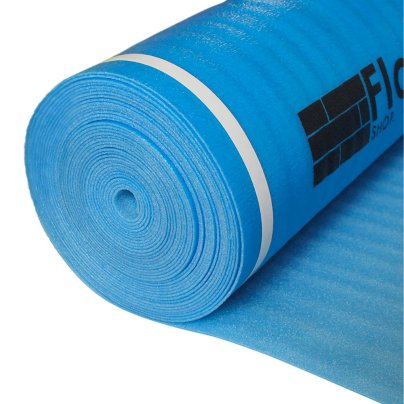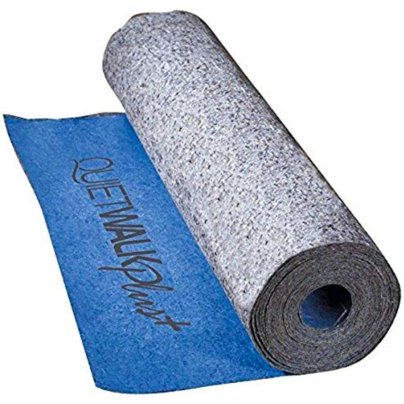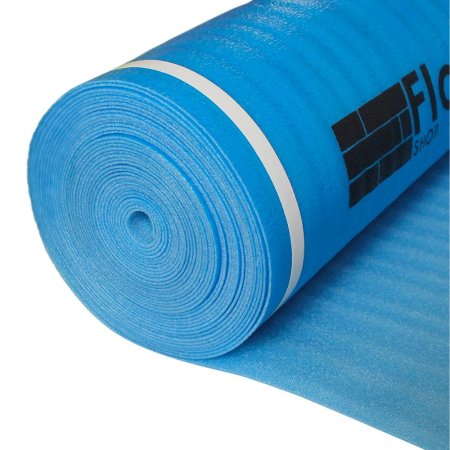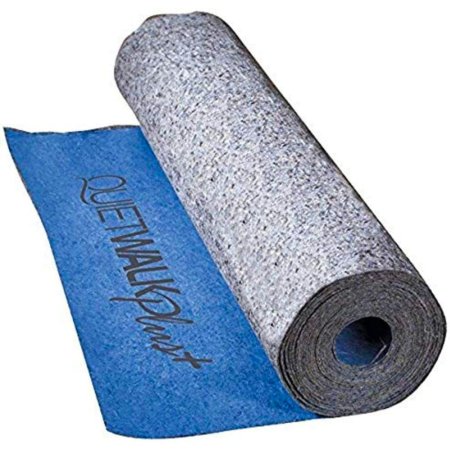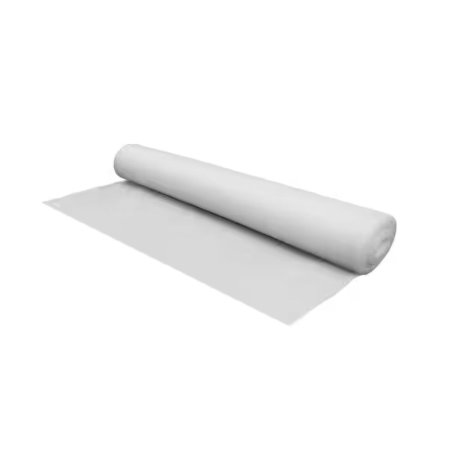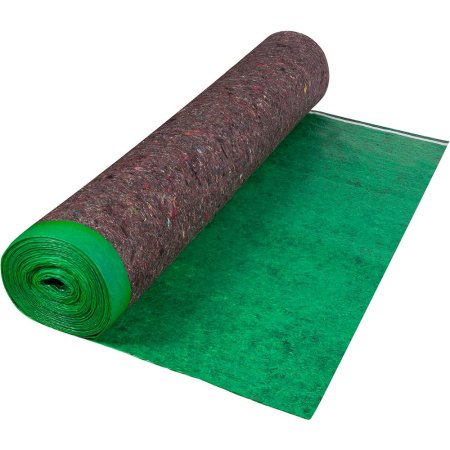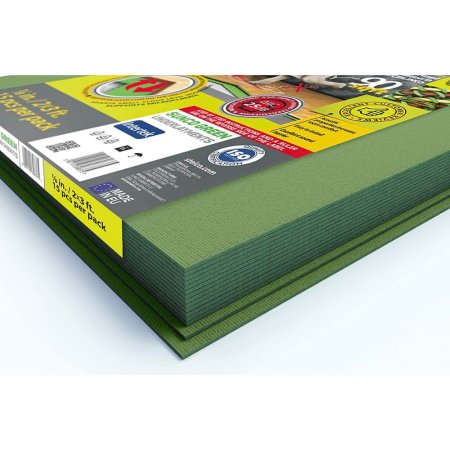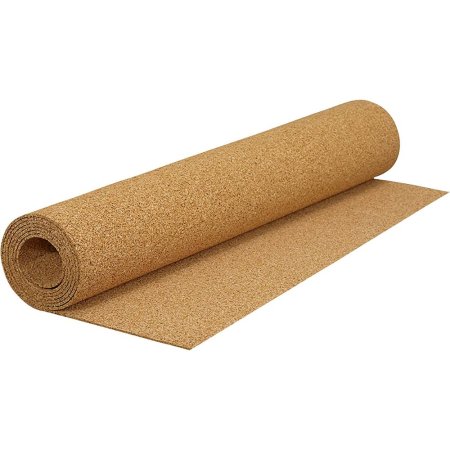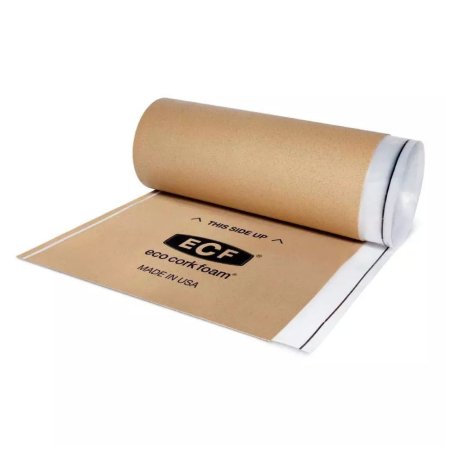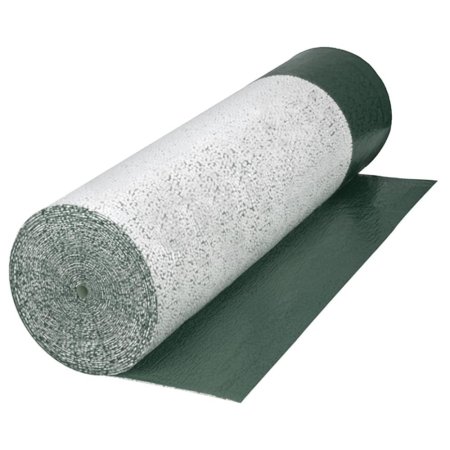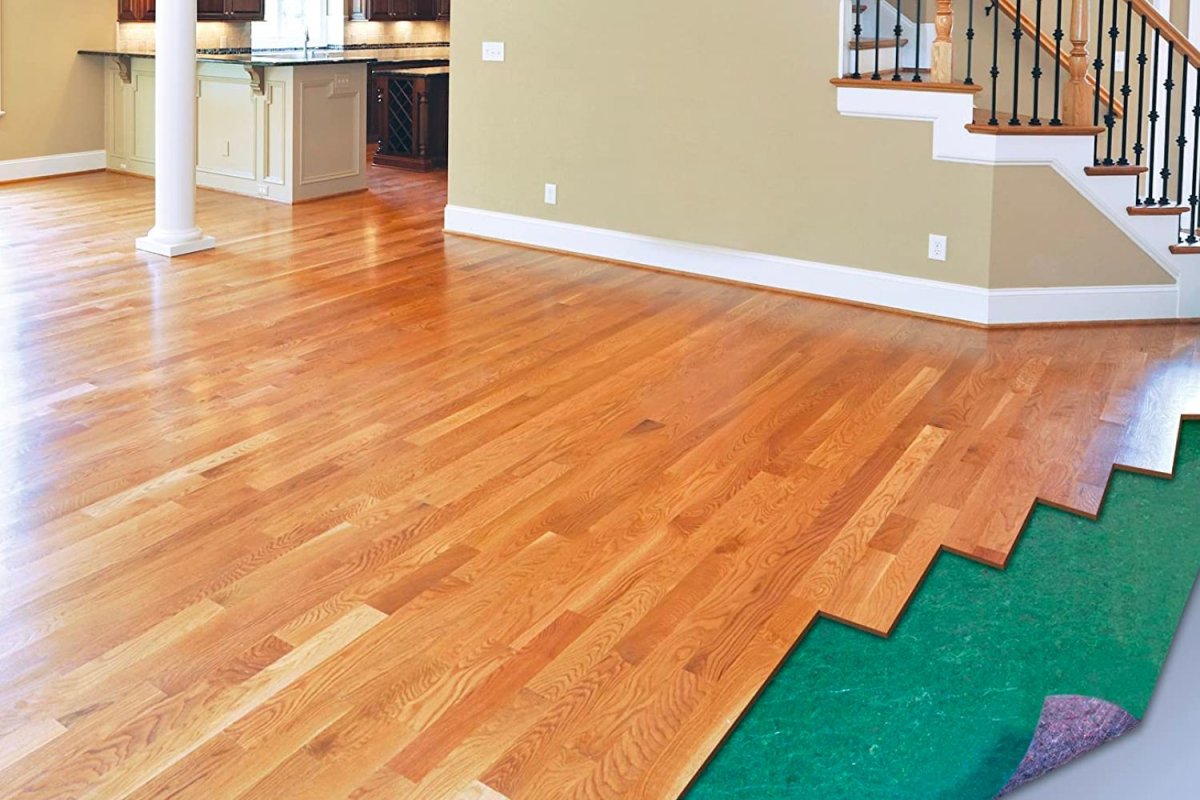
We may earn revenue from the products available on this page and participate in affiliate programs. Learn More ›
Vinyl plank flooring is becoming increasingly popular for its ability to recreate the look of solid wood while being inexpensive, durable, and water-resistant. Many don’t realize that the underlayment is nearly as important as the flooring itself.
We recommended the Floorlot Laminate Flooring Underlayment as our best overall pick because of its built-in moisture barrier, thermal insulation, and sound control. However, all our selected products were thoroughly vetted for effectiveness and reliability.
Shopping for the best underlayment for vinyl flooring online can quickly become overwhelming since there are so many options available at a wide range of prices. This article breaks down what to look for when shopping for the best underlayment for vinyl plank flooring and discusses the key considerations to keep in mind as you shop.
Keep reading for tips on choosing the best option and explore our curated picks for some of the best vinyl plank flooring underlayment.
- BEST OVERALL: Floorlot Laminate Flooring Underlayment
↓ Jump to Review - RUNNER-UP: QuietWalk Plus Acoustical Flooring Underlayment
↓ Jump to Review - BEST BANG FOR THE BUCK: Dekorman Laminate Flooring White Foam Underlayment
↓ Jump to Review - BEST FOR SOUND INSULATION: Roberts 70-193A Super Felt Underlayment
↓ Jump to Review - BEST ECO-FRIENDLY: Steico 3 mm ⅛-Inch Wood Fiber Flooring Underlayment
↓ Jump to Review - BEST THERMAL TRANSMISSION: QEP Natural Cork Underlayment Roll
↓ Jump to Review - BEST WATERPROOF: Eco Cork Foam Waterproof Premium 10-in-1 Underlayment
↓ Jump to Review - BEST ANTIMICROBIAL: Roberts 70-102 First Step Premium Underlayment
↓ Jump to Review - ALSO CONSIDER: Roberts 70-025 Qep 70-029 Unison 2-in-1 Underlayment
↓ Jump to Review

How We Chose the Best Underlayments for Vinyl Plank Flooring
Years of experience covering home improvement as well as extensive product research went into creating this guide. We explored more than 25 underlayment options and weighed a number of practical considerations before making our recommendations.
- Material: The best underlayment for floors depends largely on the type of flooring used and the subfloor present. Because of that, we included ideal underlayments made from a variety of materials in order to offer options for most shoppers. Many options on the market can pair well with luxury and engineered flooring much like those in our Flooret Flooring review.
- Thickness: Though thickness isn’t necessarily an indicator of quality when it comes to underlayments, we still opted to only include models with a minimum thickness of 2 millimeters.
- Versatility: We prioritized recommending underlayments for flooring that offered a combination of moisture protection, thermal insulation, and sound insulation.
Our Top Picks
Before calling a vinyl plank flooring installer, it’s time to start shopping. The following are our top picks for some of the best underlayments for vinyl plank flooring. These recommendations were selected because of their quality construction, excellent performance, and ease of installation. Each of the products listed below comes with a thoroughly vetted list of vinyl flooring pros and cons.
Best Overall
Floorlot Laminate Flooring Underlayment
Pros
- Includes a built-in moisture barrier to prevent the growth of mold and mildew
- Provides easy installation; comes with self-sealing tape and an overlap
- Suitable for several floor types including laminate, engineered wood, and solid wood flooring
- Provides sound absorption and thermal insulation for added user convenience
Cons
- Some users have reported that it is difficult to make this option lay flat; may require additional adhesive
Product Specs
- Material: Foam
- Thickness: 3 millimeters
- Coverage: 200 square feet
This underlayment from Floorlot is made from polyethylene foam and includes a laminated moisture barrier that prevents the development of mold, making it especially suitable for concrete subfloors. This underlayment is a good choice for slightly uneven subfloors since it smooths out any minor imperfections. It also provides sound absorption and thermal insulation. It’s incredibly versatile and can be used as an underlayment for laminate flooring along with wood and vinyl.
The roll measures 56 feet long by 3.58 feet wide, covering a total area of 200 square feet. Installation is a breeze because each roll comes with self-sealing tape. One important thing to note is that this underlayment won’t pair well with flexible vinyl plank flooring or rigid plank flooring that’s under 7 millimeters thick.
Get the Floorlot underlayment for vinyl plank flooring at Amazon, The Home Depot, or Wayfair.
Runner-Up
QuietWalk Plus Acoustical Flooring Underlayment
Pros
- Excellent soundproofing ratings and moisture resistance; STC rating of 66 and an IIC rating of 71
- Greenguard Gold certified; made with eco-friendly recycled synthetic fiber for the eco-conscious consumer
- Compatible with radiant-heat flooring systems for peak user-friendliness
Cons
- Not compatible with vinyl plank flooring over 5 millimeters thick
Product Specs
- Material: Recycled synthetic fiber
- Thickness: 3 millimeters
- Coverage: 100 square feet
Made from recycled felt, this underlayment is ideal for sound insulation with its 3-millimeter thickness. It holds an STC rating of 66 and an IIC rating of 71, guaranteeing that it will significantly reduce noise. It’s Greenguard-Gold certified, ensuring a low quantity of volatile organic compounds (VOCs) present in the material.
This can be used as an underlayment for laminate floor as well as engineered wood and bamboo. It’s even compatible with radiant in-floor heating systems. There are, however, some limitations with the type of flooring with which it’s compatible. This underlayment can only be used with floating floors and won’t work with flooring that needs to be glued or nailed down. It’s also only suitable for vinyl flooring that’s at least 5 millimeters thick.
Get the QuietWalk Plus underlayment for vinyl plank flooring at Amazon or Lowe’s.
Best Bang For The Buck
Dekorman Laminate Flooring White Foam Underlayment
Pros
- Provides cushioning and sound absorption; IIC rating of 68 and STC rating of 65
- Protects against moisture, mold, and mildew with its closed-cell foam structure
- Compatible with vinyl, bamboo, floating laminate, and engineered wood
Cons
- Some users have reported difficulties with the adhesive strip; may take some extra glue to lay flat
Product Specs
- Material: Foam
- Thickness: 2 millimeters
- Coverage: 300 square feet (comes in multiple sizes)
Made with self-adhesive tape and high-quality foam, this underlayment for vinyl plank flooring is perfect for those on a budget. It covers over 300 square feet of space, but it also comes in 100- to 200-square-foot options. It also has excellent cushioning and sound absorption with an IIC rating of 68 and an STC rating of 65. Since this underlay for vinyl flooring is made with a closed-cell foam construction, it also protects against moisture, mold, and mildew in vinyl, bamboo, floating laminate, and engineered wood flooring. It comes with self-adhesive tape for ease of installation.
Get the Dekorman underlayment for vinyl plank flooring at The Home Depot.
Best for Sound Insulation
Roberts 70-193A Super Felt Underlayment
Pros
- Excellent for sound insulation; comes with an IIC rating of 67 and STC rating of 66
- Compatible with all types of below-, on-, or above-ground concrete and wood subfloors
- Eco-friendly construction; made with heat-treated recycled fibers
- Large coverage area of 360 square feet; suitable for large homes
Cons
- High price point compared to other options on the market
Product Specs
- Material: Felt
- Thickness: 3 millimeters
- Coverage: 360 square feet
This 3-millimeter underlayment from Roberts is designed to increase comfort and absorb sound simultaneously. It features an STC rating of 66 and an IIC rating of 67, both of which indicate very effective sound insulation properties. It’s made from recycled felt fibers, making it an eco-friendly option, and features a top film vapor barrier that helps combat moisture and humidity.
In terms of subfloor compatibility, it pairs well with any flooring types including , and because of its cushioning effect, it’s perfect for using above concrete and wood subfloors. An adhesive strip and 3-inch overlap help when linking multiple rolls during the installation process, making this underlayment easy to install in large spaces.
Get the Roberts 70-193A underlayment for vinyl plank flooring at Amazon or The Home Depot.
Best Eco-Friendly
Steico 3 mm ⅛-Inch Wood Fiber Flooring Underlayment
Pros
- Constructed with natural, eco-friendly material; made with no emissions, VOCs, or glues
- High soundproofing abilities; IIC rating of 25 and an STC rating of 62
- Comes in sheets rather than rolls for easy installation; simply tape all the sheets together
- Made from absorbent materials and has a natural indoor microclimate regulator
Cons
- Small coverage area compared to other options; only covers 90 square feet
Product Specs
- Material: Wood fiber
- Thickness: 3 millimeters
- Coverage: 90 square feet
This underlayment is made from an insulating wood fiber material that’s free of VOCs, making it safe for households with children and pets. The material is ultra-absorbent, making it ideal for areas that may experience moisture damage. There are no glue additives, making this an entirely natural product.
It’s also recyclable, further reducing its environmental impact. It has a rating of -25 dB, meaning it reduces decibels by 25, providing excellent sound insulation. Its high compression strength ensures that flooring doesn’t feel bouncy and is comfortable to walk on.
It’s important to note that this underlayment only covers 90 square feet. It’s sold in sheets rather than rolls, making it easier to lay flat.
Get the Steico underlayment for vinyl plank flooring at Amazon, Lowe’s, or The Home Depot.
Best Thermal Transmission
QEP Natural Cork Underlayment Roll
Pros
- Antimicrobial properties prevent and repel termites, insects, mold, mildew, and pests
- Works well for thermal transmission to improve the functionality of floor heating systems
- Resists any stress cracks from subfloors to prevent bumps or uneven flooring
- Made from eco-friendly cork material for the eco-conscious consumer
Cons
- High price point compared to other options on the market
Product Specs
- Material: Cork
- Thickness: 6 millimeters
- Coverage: 200 square feet
Cork underlayments for vinyl floors offer a number of advantages: They’re naturally hypoallergenic and offer excellent moisture and sound absorption. This type of underlayment also reduces thermal transmission, making it the ideal choice for those with radiant heated floors. Cork is a renewable resource, so underlayments made of cork are an eco-friendly choice. This particular model offers 200 square feet of coverage and works well for uneven subfloors since it’s firmer than underlayments made from other materials.
At 6 millimeters, this underlayment is much thicker than those made from other materials, so it’s important to ensure that all flooring will remain level even with the 6 millimeter elevation.
Best Waterproof
Eco Cork Foam Waterproof Premium 10-in-1 Underlayment
Pros
- 10-in-1 functionality; waterproof, antimicrobial, eco-friendly, noise reducing, and promotes even weight distribution
- Easy installation thanks to self-sealing tape; can protect tongue-and-groove connections
- Low-VOC construction is safe for homes with children and pets
- Compatible with a variety of flooring types for peak versatility
Cons
- Some users have reported that the underlayment takes some time to unroll
Product Specs
- Material: Polyethylene and granulated cork
- Thickness: ⅛ inch
- Coverage: 75 square feet (comes in different size options)
Prevent damage to a home in the event of a flood with the Eco Cork Foam waterproof underlayment. This low-VOC polyethylene and granulated cork underlayment is made with a waterproof 6-milliliter vapor barrier and has antimicrobial properties; an R-value of 0.48; a nontoxic, eco-friendly construction; a ⅛-inch thickness; noise-reducing capabilities; self-sealing tape; and the ability to promote even weight distribution. It is made to be used as an underlay for laminate flooring as well as engineered wood, solid wood, and concrete and protects tongue-and-groove connections.
Best Antimicrobial
Roberts 70-102 First Step Premium Underlayment
Pros
- Excellent value for the price point; covers over 630 square feet of space
- Offers antimicrobial protection to deter pests, mold, and mildew
- Excellent soundproof ratings; IIC rating of 68 and STC rating of 67
Cons
- Only compatible with floating flooring varieties; may not meet individual user needs
Product Specs
- Material: Polystyrene
- Thickness: 2 millimeters
- Coverage: 630 square feet
This underlayment from Roberts features Gold Guard antimicrobial protection and offers advanced air circulation, which inhibits mold growth. Additionally, it helps with noise reduction (with an IIC rating of 68 and STC rating of 67), moisture protection, comfort, and even helps to level imperfections in the subfloor. It’s only compatible with floating flooring and can’t be used with vinyl flooring that needs to be nailed or glued down. It is, however, compatible with all types of subfloor.
This underlayment is available in a much larger roll than many of its competitors, offering 630 square feet of coverage. Because of this, it offers great value when flooring large spaces.
Get the Roberts 70-102 underlayment for vinyl plank flooring at Amazon.
Best Antimicrobial
Roberts 70-025 Qep 70-029 Unison 2-in-1 Underlayment
Pros
- Protects against moisture while providing cushion; keeps floors mold- and mildew-free
- Soundproof capabilities integrated; IIC rating of 61 and an STC rating of 54
- Suitable for use over heated flooring varieties for added user convenience
- Easy installation; comes with a 3-inch overlap flap and adhesive strip
Cons
- Some users have reported that this option does not feel as thick as other options; may not even out some bumps
Product Specs
- Material: Polyethylene foam
- Thickness: 3.32 millimeters
- Coverage: 100 square feet
This underlayment from Roberts has two layers of material: 3.32 millimeters of polyethylene foam, which provides comfort, and 2 millimeters of film, which acts as a moisture and vapor barrier. It offers an R-value of 0.29, ensuring solid thermal insulation. In terms of sound insulation, it holds an IIC rating of 61 and an STC rating of 54, which is on the slightly lower end, making this underlayment less than ideal for reducing noise.
It can be used as a floor underlayment for laminate over radiant-heated floors and engineered hardwood floors. A plastic overlap and adhesive strip make it easy to join multiple rolls during installation.
Get the Roberts 70-025 underlayment for vinyl plank flooring at Amazon.
Jump to Our Top Picks
What to Consider When Choosing Underlayments for Vinyl Plank Flooring
While it’s easy to assume that all vinyl flooring underlayment offers similar performance, a number of factors affect its functionality. Features like operating frequency, ground balance, search modes, and item discrimination can make one better for a user’s needs than another option. Keep reading to learn about these important features to consider when choosing the best underlayment for vinyl plank flooring.
Type
There are several different types of underlayments for vinyl plank flooring, all of which have unique advantages. Here are some of the most popular:
- Foam is a favorite choice because it’s inexpensive yet effective. Foam pairs particularly well with wooden subfloors. It’s important to note, however, that foam isn’t the ideal choice for spaces that experience moisture issues.
- Felt is a top-notch choice for providing sound insulation but is typically thin so it doesn’t provide any added comfort. Because it’s made from recycled fibers, felt is an eco-friendly option.
- Cork provides excellent sound insulation and is a good choice in areas that experience mold and mildew. It’s a great option for households with allergy sufferers.
- Particleboard is an inexpensive option, but it can’t handle exposure to moisture and isn’t particularly strong.
- Plywood draws comparisons to particleboard but is a better option because it isn’t as easily damaged by moisture.
- Rubber protects against moisture and provides great sound and thermal insulation.
- Oriented strand board (OSB) is more durable than plywood, though it has a similar makeup.
Subfloor Type
The best type of underlayment to choose depends largely on the subfloor type.
- Concrete subfloors are very hard, so they require additional cushioning from soft underlayments made from foam, felt, or cork. When choosing an underlayment for vinyl plank flooring on concrete, it’s best to pick an option that provides heat insulation and moisture regulation.
- Wood subfloors do an excellent job of regulating temperatures and controlling moisture, but they don’t absorb sound, so a felt underlayment makes for a great pairing.
- Existing floors are sometimes used as a subfloor. In this case, rigid underlayments are the best choice because they level out any unevenness.
Flooring Type
Vinyl plank flooring has several subvarieties, each of which has different requirements when it comes to an underlayment. Vinyl plank flooring is typically categorized as either rigid or flexible.
The most durable option available is rigid vinyl plank flooring. Engineered vinyl plank (EVP) flooring (also known as rigid core luxury vinyl flooring) can be made with three different cores: stone-plastic composite (SPC), wood-plastic composite (WPC), and pure vinyl. SPC floors aren’t as comfortable, so they pair best with soft underlayments made from foam, felt, and cork. WPC floors are thicker, so they often necessitate a thinner underlayment. Pure vinyl floors lack durability and comfort, so they need the highest-grade underlayment available.
Flexible vinyl plank flooring is often used as a budget or temporary solution since it comes in a peel-and-stick format and doesn’t offer the same level of quality or durability as rigid vinyl flooring.
Moisture and Vapor Protection
Vinyl plank flooring is designed to be waterproof but can still warp if exposed to moisture that comes from the subfloor. Using a vapor barrier underlayment alongside a standard underlayment may be necessary in damp areas like flooring in basements. Some underlayments are designed with antimicrobial properties so that they can prevent the development of mold spores in damp or humid areas.
According to Rotem Eylor, founder and CEO of Republic Floor in California, moisture resistance in underlayment is very important: “issues with moisture can cause significant damage to the flooring. If moisture spreads, it can cause warping, expansion, wood rot etc. It can also lead to mold and create health concerns to homeowners.”
Thickness
Generally speaking, underlayments for vinyl flooring are between 2 and 3 millimeters thick, though they may be as thin as 1 millimeter or as thick as 6 millimeters. It would be easy to assume that a thicker underlayment would indicate a higher level of performance, but innovations in manufacturing have made it possible for thin underlayments to offer top-notch comfort and insulation. Underlayment thickness is primarily a consideration when using different types of flooring throughout a house. If the kitchen has tile floors, for example, it’s important to ensure that they are at the same height as the vinyl plank flooring when considering the thickness of the underlayment.
Thermal and Sound Insulation
Using an underlayment helps to prevent cold floors in winter by providing an extra layer of thermal insulation. This results in lower heating costs, saving money in the long run. Some types of underlayment will be rated with an R-value, which indicates how much thermal insulation it provides. A higher R-value indicates better insulation. Look for an R-value between 0.2 and 0.4.
One of the key benefits of a vinyl flooring underlayment is sound insulation. This is particularly important if the vinyl planks are installed on the upper floor of a home or apartment. The level of sound insulation that an underlayment provides may be measured in negative decibels (-dB), or rated by Impact Insulation Class (IIC) or Sound Transmission Class (STC).
Rotem Eylor shared his expert opinion on this matter too, stating that “shoppers should pay attention to factors like stability cushioning and thermal installation, which would be an acoustic underlayment (cork, rubber, felt or anything that absorbs sound well).”
Tips for Installing Underlayments for Vinyl Plank Flooring
Now that you’ve chosen the perfect underlayment to pair with your vinyl plank floors, it’s time to consider installation. Most products will come with clear manufacturer instructions, and it’s essential to follow these as closely as possible to ensure the product is installed correctly, which can cut costs for installing vinyl plank flooring. Here’s how to install underlayment for vinyl plank flooring:
- Follow the manufacturer’s instructions
- Clean the subfloor thoroughly
- Lay out the underlayment from wall to wall, cutting pieces to fit
- Ensure there are no gaps between pieces
- Use an adhesive to connect the various pieces
FAQs
While you now know more about choosing the best underlayments for vinyl plank flooring, you might still be looking for more information about how they work. Here are answers to some of the most frequently asked questions about vinyl flooring underlayments.
An underlayment places a barrier between the subfloor and the flooring itself. This layer acts as a moisture barrier, reduces noise, and potentially makes the floors more comfortable to walk on.
Before choosing an underlayment for vinyl plank flooring, it’s important to check with the manufacturer to establish whether an underlayment is necessary. Some companies will clearly specify the type of underlayment that needs to be used. Some will even void the flooring’s warranty if the wrong type of underlayment is used.
A vapor barrier underlayment or moisture barrier underlayment can be used as an alternative to or in conjunction with a standard underlayment in areas that experience moisture to prevent the development of mold.
Underlayments designed for vinyl plank flooring are typically between 1 and 3 millimeters thick, with a minimum thickness of ¼ inch. The thickness of a given underlayment can even out flooring and provide cushioning.
A concrete floor needs underlayment to provide a vapor barrier while providing cushioning and temperature control, which is perfect for those that have heated flooring systems. Some underlayments also come with moisture barriers that can prevent and repel moisture, mold, and mildew.
